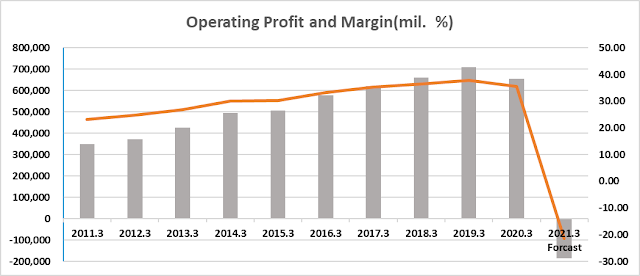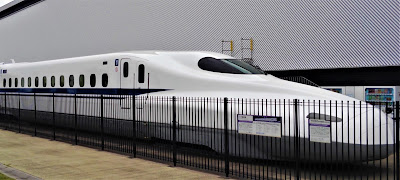Investing in Japan: Central Japan Railway Company suffers from the pandemic but the worst seems to have passed
JR Central posted the first deficit since its privatization
The number of railway users in Japan declined due to the spread of the new coronavirus infection. The consolidated earnings forecast for the fiscal year ending March 2021 announced by Central Japan Railway Company (JR Central) is that sales will decrease 53.2% from the previous year to 863 billion yen ending up with operating loss of 185 billion yen, ordinary loss of 258 billion yen and net loss of 192 billion yen.
This is the first full-year deficit since 1987 when JR Central was privatized. JR Central expects that railroad use will continue to stagnate until the end of the year and then it will recover after that. Especially, rebound of the Shinkansen's business is sluggish compared to the conventional lines. The stagnation has a major impact on JR Central's profits as approximately 90% of the profits of JR Central's railway business come from Tokaido Shinkansen.
In addition, sales of department stores and hotels operated by JR Central
decreased due to the spread of the new coronavirus infection, which forced them
to shorten business hours and temporarily close their businesses.
The government programs stimulate tourism and restaurant industry
To cope with those situations the Japanese government has been promoting “Go To Travel” campaign and subsidizing domestic travels. It aims to increase tourists strongly and encourage spending contributing to boost economic activities suffering from the global pandemic although the program may be partially suspended to contain recent spike in new cases.
Some statistics show that economic activity is slowly recovering from the effects of the new coronavirus pandemic. For example, according to Consumer Confidence Survey released by the Cabinet Office, the Consumer Confidence Index (seasonally adjusted) which indicates consumer sentiment in October 2020 was 33.6, up 0.9 points from the previous month, rising for the second straight month. The Cabinet Office analyzes that consumer sentiment remains harsh but keeps bottoming out gradually.
It seems that the government's support programs such
as “Go To Travel” and “Go To Eat”, have supported the consumer sentiment and
stimulated demand. “Go To Eat” campaign is aimed to help restaurants hit hard
by the novel coronavirus crisis by issuing meal coupons good for 25 percent off
food and drinks. The coupons can be used at registered restaurants in areas
where they are issued. The campaign also rewards points worth up to 1,000 yen
per person who eats at restaurants booked online.
COVID-19 new cases and the government support measures play a tug of war
According to the preliminary figures of the accommodation travel statistics survey released by the Japan Tourism Agency, the number of Japanese who stayed at hotels and inns in Japan in September made some progress. The deterioration rate has improved significantly from minus 51.8% in August to minus 37.4% although the severe situation continues. Four consecutive holidays in September may have helped “Go To Travel” campaign to fuel travel demand.
However, the Japanese government and local governments are watching closely how COVID-19 new cases take hold to decide whether they can proceed those programs as planned. Tourism industry is put under a tug of war between COVID-19 new cases and the government support measures, but people are apt to return to their normal life as they did before the pandemic and as for Shinkansen business it is in the case. The number of Shinkansen users has been gradually increasing recently.
On the other hand, a spread of COVID-19 may force travel agencies to temporarily stop taking new reservations under the “Go To Travel” campaign for destinations where infections are on the rise at a certain pace. The Japanese government may also ask prefectural governors to take measures to scale back on sales of coupons or use of points in “Go To Eat” program.
The JR Central’s core business is finally turning around
According to JR Central’s announcement, the number of passengers of Tokaido Shinkansen is recovering gradually since April when the pandemic caused the catastrophic deterioration. In October, the number recovered to the level of 46% year on year.
In April when the pandemic holt economic activities completely after the Japanese government declared the state of emergency, it plunged to only 10% of the previous year. The improvement continues in November with the monthly comparison increasing slightly to 47% as of November 17.
Those data imply that although the daily new cases of infection
are increasing and stricter prevention measures may be introduced again, business
and tourism activities seem to be on a recovery truck. Investors infer carefully
the media reports and the government data on COVID-19 cases in an effort to
find a reassurance that recent situation does not derail Japan’s economic
recovery.
Valuation Metrics (As of Nov. 20, 2020)
Market Cap: 2.819 Trillion yen
The price-to-earnings ratio: 105.25
Price-to-book ratio: 0.78
Trailing Annual Dividend Yield: 0.95%






Comments
Post a Comment